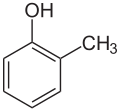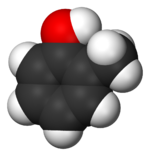O-Cresol: Difference between revisions
Updating {{chembox}} (no changed fields - added verified revid) per Chem/Drugbox validation (report errors or bugs) |
Sciencelab.com is a fraud. http://www.resellerratings.com/store/ScienceLab, http://www.bbb.org/houston/business-reviews/petroleum-products/science-lab-com-in-humble-tx-13007572/ |
||
| Line 35: | Line 35: | ||
| Section7 = {{Chembox Hazards |
| Section7 = {{Chembox Hazards |
||
| MainHazards = Highly toxic. May be fatal if inhaled, swallowed or absorbed through skin. Experimental neoplastigen. Human mutagenic data. Readily absorbed through the skin. Very destructive of mucous membranes. Causes burns. Inhalation may cause spasm. Severe skin and eye irritant. |
| MainHazards = Highly toxic. May be fatal if inhaled, swallowed or absorbed through skin. Experimental neoplastigen. Human mutagenic data. Readily absorbed through the skin. Very destructive of mucous membranes. Causes burns. Inhalation may cause spasm. Severe skin and eye irritant. |
||
| ExternalMSDS = [ |
| ExternalMSDS = [https://fscimage.fishersci.com/msds/95810.htm External MSDS] |
||
| FlashPt = 81 °C |
| FlashPt = 81 °C |
||
| RPhrases = {{R24}} {{R25}} {{R34}} |
| RPhrases = {{R24}} {{R25}} {{R34}} |
||
Revision as of 17:34, 12 March 2010

| |

| |
| Names | |
|---|---|
| IUPAC name
2-Methylphenol
| |
| Other names
2-Hydroxytoluene
ortho-cresol | |
| Identifiers | |
3D model (JSmol)
|
|
| ECHA InfoCard | 100.002.204 |
| RTECS number |
|
CompTox Dashboard (EPA)
|
|
| |
| Properties | |
| C7H8O | |
| Molar mass | 108.14 g/mol |
| Appearance | colorless crystals or liquid |
| Density | 1.0465 g/cm³, liquid at 20 °C |
| Melting point | 29.8 °C |
| Boiling point | 191.5 °C |
| 3.1 g/100 ml at 40 °C 5.6 g/100 ml at 100 °C | |
| Solubility in ethanol | fully miscible at > 30 °C |
| Solubility in diethyl ether | fully miscible at > 30 °C |
| Acidity (pKa) | 10.26 |
Refractive index (nD)
|
1.5353 |
| Viscosity | 35.06 cP at 45 °C |
| Hazards | |
| Occupational safety and health (OHS/OSH): | |
Main hazards
|
Highly toxic. May be fatal if inhaled, swallowed or absorbed through skin. Experimental neoplastigen. Human mutagenic data. Readily absorbed through the skin. Very destructive of mucous membranes. Causes burns. Inhalation may cause spasm. Severe skin and eye irritant. |
| NFPA 704 (fire diamond) | |
| Flash point | 81 °C |
| Related compounds | |
Except where otherwise noted, data are given for materials in their standard state (at 25 °C [77 °F], 100 kPa).
| |
ortho-Cresol, also 2-methylphenol, is a phenol, with formula (CH3)C6H4(OH).
It is an isomer of p-cresol, m-cresol and anisole
Chemistry
Cresols are organic compounds which are methylphenols. They are a widely occurring natural and manufactured group of aromatic organic compounds which are categorized as phenols (sometimes called phenolics). Depending on the temperature, cresols can be solid or liquid because they have melting points not far from room temperature. Like other types of phenols, they are slowly oxidized by long exposure to air and the impurities often give cresols a yellowish to brownish red tint. Cresols have an odor characteristic to that of other simple phenols, reminiscent to some of a "medicine" smell.
In its chemical structure, a cresol molecule has a methyl group substituted onto the benzene ring of a phenol molecule. There are three forms of cresols that are only slightly different in their chemical structure: ortho-cresol (o-cresol), meta-cresol (m-cresol), and para-cresol (p-cresol). These forms occur separately or as a mixture.
Applications
Cresols are used to dissolve other chemicals, as disinfectants and deodorizers, and to make specific chemicals that kill insect pests.
Cresol solutions are used as household cleaners and disinfectants, perhaps most famously under the trade name Lysol. In the past, cresol solutions have been used as antiseptics in surgery, but they have been largely displaced in this role by less toxic compounds. Lysol was also advertised as a disinfecting vaginal douche in mid-twentieth century America[1].
Cresols are found in many foods and in wood and tobacco smoke, crude oil, coal tar, and in brown mixtures such as creosote, cresolene and cresylic acids, which are wood preservatives. Small organisms in soil and water produce cresols when they break down materials in the environment.
Health effects
Most exposures to cresols are at very low levels that are not harmful. When cresols are breathed, ingested, or applied to the skin at very high levels, they can be very harmful. Effects observed in people include irritation and burning of skin, eyes, mouth, and throat; abdominal pain and vomiting; heart damage; anemia; liver and kidney damage; facial paralysis; coma; and death.
Breathing high levels of cresols for a short time results in irritation of the nose and throat. Aside from these effects, very little is known about the effects of breathing cresols, for example, at lower levels over longer times.
Ingesting high levels results in kidney problems, mouth and throat burns, abdominal pain, vomiting, and effects on the blood and nervous system.
Skin contact with high levels of cresols can burn the skin and damage the kidneys, liver, blood, brain, and lungs.
Short-term and long-term studies with animals have shown similar effects from exposure to cresols. No human or animal studies have shown harmful effects from cresols on the ability to have children.
It is not known what the effects are from long-term ingestion or skin contact with low levels of cresols.

